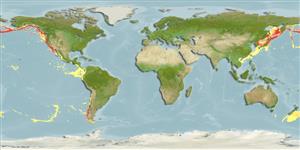Common names from other countries
>
Perciformes/Zoarcoidei (Eelpouts and pricklebacks) >
Zoarcidae (Eelpouts) > Lycodinae
Etymology: Bothrocara: Greek, bostrykos = cure of lack of hair + Tupí, guaraní, acará = the name of a fish. It could be also from Greek, kara = face (Ref. 45335).
More on author: Bean.
Environment: milieu / climate zone / depth range / distribution range
Ecología
marino batidemersal; rango de profundidad 129 - 2570 m (Ref. 50550), usually 457 - ? m (Ref. 2850). Deep-water
North Pacific: Sakhalin, Russia and Navarin Canyon in the Bering Sea to Attu Island in the Aleutian chain and Coronado Islands, Baja California, Mexico.
Tamaño / Peso / Age
Maturity: Lm ? range ? - ? cm
Max length : 74.0 cm TL macho / no sexado; (Ref. 80637)
Short description
Claves de identificación | Morfología | Morfometría
Espinas dorsales (total) : 0; Radios blandos dorsales (total) : 100 - 112; Espinas anales: 0; Radios blandos anales: 95 - 100. Dorsal and anal fins enveloped anteriorly in soft gelatinous tissue (Ref. 6885). Uniform light gray or brown, semi translucent, blue or black margins on dorsal and anal fins; color stronger posteriorly, transparent on narrow margins of unpaired fins; light on lining on mouth; black on peritoneum (Ref. 6885).
Found on mud or sandy-mud bottoms (Ref. 2850). The stomach contents indicate that it feeds upon a wide variety of bottom-dwelling organisms, probably eating anything it encounters that has food value and is small enough to ingest (Ref. 4525).
Life cycle and mating behavior
Maturities | Reproducción | Spawnings | Egg(s) | Fecundities | Larva
Eschmeyer, W.N., E.S. Herald and H. Hammann, 1983. A field guide to Pacific coast fishes of North America. Boston (MA, USA): Houghton Mifflin Company. xii+336 p. (Ref. 2850)
IUCN Red List Status (Ref. 130435)
CITES (Ref. 128078)
Not Evaluated
Threat to humans
Harmless
Human uses
Herramientas
Special reports
Download XML
Fuentes de Internet
Estimates based on models
Preferred temperature (Ref.
115969): 0.2 - 4.8, mean 2.6 (based on 298 cells).
Phylogenetic diversity index (Ref.
82804): PD
50 = 0.5039 [Uniqueness, from 0.5 = low to 2.0 = high].
Bayesian length-weight: a=0.00186 (0.00113 - 0.00307), b=3.25 (3.10 - 3.40), in cm Total Length, based on LWR estimates for this species & (Sub)family-body (Ref.
93245).
Nivel trófico (Ref.
69278): 3.6 ±0.0 se; based on diet studies.
Resiliencia (Ref.
120179): Medio, población duplicada en un tiempo mínimo de 1.4-4.4 años (Fec=1,650-2,480).
Fishing Vulnerability (Ref.
59153): Moderate to high vulnerability (50 of 100).
